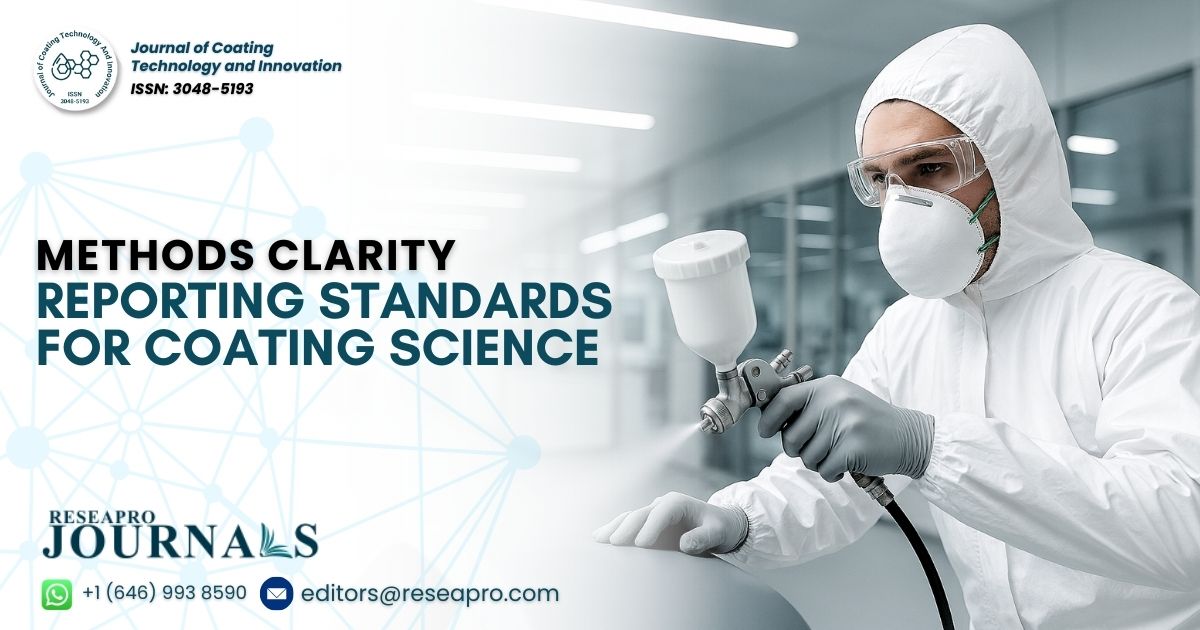Methods Clarity
Reproducibility begins with transparent, complete methods. This guide defines the essential reporting elements for manuscripts submitted to Journal of Coating technology and Innovation so that peers can evaluate rigor and practitioners can build upon your work.
1) Materials and Substrates

- Precursors, powders, monomers, binders, solvents (supplier, purity, lot/batch IDs).
- Substrate material/grade, dimensions, surface finish/roughness, and pre-treatment (e.g., grit blasting, etching).
- Safety/environmental notes (e.g., hexavalent Cr alternatives, low‑VOC formulation).
2) Deposition / Curing Parameters
- Technique and equipment (model/year, torch/gun/cathode, nozzle/orifice, chamber size).
- Process settings: power/voltage/current, gas type/flows, pressures, stand‑off distance, traverse speed, duty cycle, substrate temperature.
- Feedstock properties: particle size distribution, solid content/viscosity, solvent ratios, atomization pressure, preheat schedules.
- Layer architecture: number of passes, raster strategy, dwell times, inter-pass cooling, bond coats, interlayers.
3) Post‑Treatment & Conditioning
- Heat treatments (time/temperature/atmosphere), densification, sealing, or irradiation (UV/EB).
- Machining/finishing steps (polishing grit sequence, lapping fluids), cleaning, and storage conditions.
- Aging protocols prior to testing (humidity/temperature cycles, saline soak, solvent evaporation).
4) Characterization & Testing
- Microstructure: XRD parameters, SEM accelerating voltage/WD, TEM foil prep, XPS/ToF‑SIMS settings.
- Adhesion/scratch: test standard (e.g., ASTM C633, D4541, D3359), loading rate, substrate fixture, failure mode.
- Mechanical: hardness (HV/HK scales, load/dwell), instrumented indentation (Oliver–Pharr), modulus extraction.
- Tribology: pin‑on‑disk, block‑on‑ring; normal load, sliding speed, counterpart material/roughness, environment, wear coefficient method.
- Corrosion: EIS/TPD/potentiodynamic scans (electrolyte, reference/counter electrodes, immersion time); salt spray/cyclic exposure standards.
- Functional: contact angle (needle/tilt method), optical spectra (range/resolution), thermal conductivity (TPS/LFA), emissivity.
5) Data Integrity & Statistics
- Replicates and sampling (number of runs, coatings per run, locations per specimen).
- Uncertainty reporting: SD/SEM/CI, outlier criteria, and power considerations where relevant.
- Image ethics: full fields where possible; avoid aggressive contrast; show scales and analysis ROI.
6) Mechanisms, Modeling, and Validation
- Relate process parameters to microstructure and properties via coherent mechanisms.
- Use comparative baselines and standards; include ablation studies for key variables.
- If modeling is used (CFD/DEM/phase field/FE), report inputs, boundary conditions, and verification; align simulations with experiments.
7) Sustainability & Safety
- Report solvent class, VOC content, and waste treatment; highlight bio‑based or waterborne alternatives.
- Energy and material efficiency metrics where feasible; discuss scale‑up constraints and environmental trade‑offs.
Submission Readiness Checklist
- Parameter tables and instrument settings included in Supplementary Material.
- Source data (CSV) available for plots; figure callouts consistent with captions.
- All units SI; uncertainty included; standards referenced; safety notes provided.
To know more about the scope of the Journal, read our latest blog.

